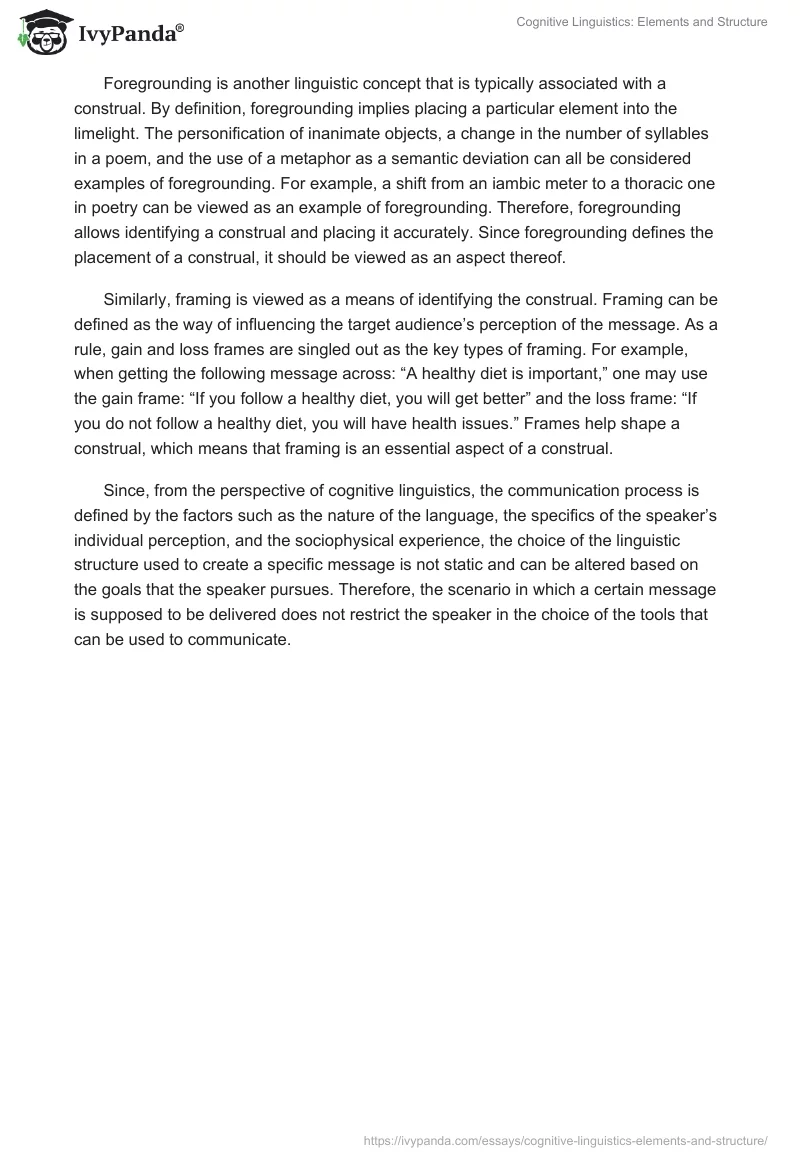The concept of cognitive linguistics is complex in its simplicity. The very idea that makes the foundation for a better understanding of how language works, how it develops, and how the communication process occurs, is rooted in the relationship between the nature of the language, the speaker’s perception, and the sociophysical experience that provides the impetus for producing speech. Therefore, it can be stated that there is no direct correlation between the elements of a particular situation and the linguistic structure used to convey the meaning.
At this point, the concept of a construal needs to be mentioned. Typically defined as the elements of a situation that refer to specific linguistic elements, construals allow creating the perspective from which a situation can be observed and interpreted. When considering examples of how elements of speech can be used in a specific linguistic situation, one may bring up the use of a metaphor.
Being one of the most common tools for introducing a unique meaning to a particular speech, a metaphor is a graphic that proves that there is no correlation between the choice of the structure and the meaning of the message. For example, using the expression “ocean of tears,” one creates the metaphor for grief, therefore, building a link between the domains of familiar and new meanings (i.e., the images of an ocean and tears and the notion of grief). Similarly, the expression “You’ve lost me” as the substitute for the following message: “I do not understand you” implies a change in the structure of the message and at the same time suggests that the idea of understanding someone could be represented by, or construed as, being lost.
The concept of perspective also has to be addressed when considering the way in which the linguistic structure interacts with the meaning of the message. Particularly, the proponents of cognitive linguistics point to the fact that a significant change in the form of a message does not necessarily trigger an immediate change in its meaning. The use of the Passive Voice versus the Active Voice is a common example; for instance, the following sentences have the same meaning despite the obvious difference in their structure: “Betty fed the cat” and “The cat was fed by Betty.”
Foregrounding is another linguistic concept that is typically associated with a construal. By definition, foregrounding implies placing a particular element into the limelight. The personification of inanimate objects, a change in the number of syllables in a poem, and the use of a metaphor as a semantic deviation can all be considered examples of foregrounding. For example, a shift from an iambic meter to a thoracic one in poetry can be viewed as an example of foregrounding. Therefore, foregrounding allows identifying a construal and placing it accurately. Since foregrounding defines the placement of a construal, it should be viewed as an aspect thereof.
Similarly, framing is viewed as a means of identifying the construal. Framing can be defined as the way of influencing the target audience’s perception of the message. As a rule, gain and loss frames are singled out as the key types of framing. For example, when getting the following message across: “A healthy diet is important,” one may use the gain frame: “If you follow a healthy diet, you will get better” and the loss frame: “If you do not follow a healthy diet, you will have health issues.” Frames help shape a construal, which means that framing is an essential aspect of a construal.
Since, from the perspective of cognitive linguistics, the communication process is defined by the factors such as the nature of the language, the specifics of the speaker’s individual perception, and the sociophysical experience, the choice of the linguistic structure used to create a specific message is not static and can be altered based on the goals that the speaker pursues. Therefore, the scenario in which a certain message is supposed to be delivered does not restrict the speaker in the choice of the tools that can be used to communicate.


